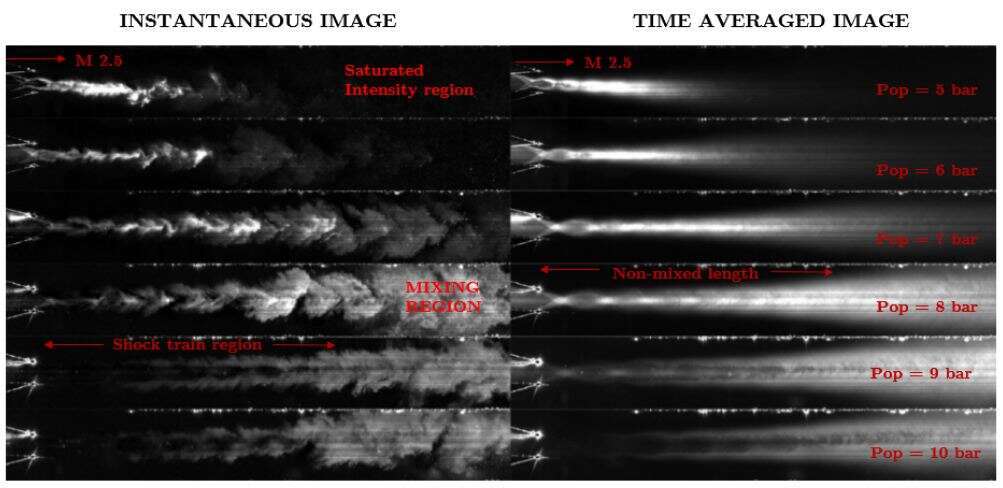Understanding the flow physics of confined supersonic jet is of primary importance in the design of the supersonic ejector systems [1]. Supersonic ejectors are reportedly used in gas dynamic lasers, wind tunnels, propulsive devices and refrigeration units. One important parameter of study in such device is non-mixed length [2]. This paper explores the non-mixed length variation for different primary flow supersonic Mach numbers at different stagnation pressure ratio, using optical diagnostics tool – Planar Laser Mie Scattering (PLMS) [3]. For this experimentation, an existing 2-D constant area supersonic ejector facility is utilized [4]. A typical flow field in the supersonic ejector is sketched in Fig. 1. Acetone vapors are used to seed the flow. These vapors are generated by an in-house particle generator designed based on the modified Laskin nozzle [5]. Produced vapors are fed into the primary flow stagnation chamber for the seeding of primary supersonic flow, with an over-pressure ratio of 2 bar. Nd-YLF laser at 527 nm firing at a rate of 0.8 kHz with an energy of 24 mJ is used as a light source to illuminate the seeded flow field. The laser pulse width is 100 ns and the sheet thickness is approximately 1 mm. A high speed camera (Phantom Miro 110) with 1280 X 800 pixels is used to acquire images. Nearly 800 images are used in time averaging.
![Schematics of the flow physics inside a 2D Supersonic Ejector [4]](http://events.eventact.com/Ortra/16496/Fig_1.JPG)
Figure 1: Schematics of the flow physics inside a 2D Supersonic Ejector [4]
Four nozzles with design Mach number (Md) of 1.5, 2.0, 2.5 and 3.0 are used in these experiments. The primary supersonic flow stagnation chamber pressure (Pop) is varied from 5 bar to 10 bar. The non-mixed length is obtained in terms of the constant area mixing duct height (H) for different Md and Pop.

Figure 2: Observed flow field by Planar Laser Mie Scattering (PLMS) in the confined supersonic jet at a design Mach number (Md) of 2.0 with the primary flow stagnation pressure (Pop) of 6 bar using acetone seeding (a) secondary flow seeding, (b) primary flow seeding
Fig. 2(a) and Fig. 2(b) are instantaneous images showing typical flow structures observed when the secondary flow and the primary flow are seeded alternately. When the secondary flow is seeded, the image Fig. 2(a) provides qualitative information on the extent of the potential core of the primary flow. Upon seeding the primary flow Fig. 2(b), the first shock cell and the distance for which primary and secondary flow are distinct is evident. The non-mixed length can be determined from Fig. 2(b) by computing the mixing parameter (β) [6] from simple transverse intensity profiles across the length of the ejector. Fig. 3 is composed of instantaneous images on the left side and the corresponding time averaged image on the right hand side for different Pop at Md of 2.5. While the instantaneous images show details of turbulent flow structures distinctly, the time averaged images bring out the variation of non-mixed length within the ejector for different Pop.

Figure 3: Planar Laser Mie Scattering (PLMS) experiments at different primary flow stagnation pressure (Pop) at a design Mach number (Md) of 2.5 (left: instantaneous images, right: time averaged images)
More details on the methodology, flow evolution and the observation of non-mixed length variation will be presented in detail in the main paper.
References
- K. Kontis, G. Jagadeesh and S. Rao, "Encyclopedia of Aerospace Engineering," in Compressible flow in internal ducts, UK, John Wiley & Sons, Ltd, 2010.
- S. Rao and G. Jagadeesh, "Observations on the non-mixed length and unsteady shock motion in a two dimensional supersonic ejector," Physics of Fluids, vol. 26, p. 26, 2014.
- N. Clemens and M. Mungal, "A planar mie scattering technique for visualizing supersonic mixing flows," Experiments in Fluids, vol. 11, no. 1, pp. 175-185, 1991.
- S. Rao, "Experimental investigations on supersonic ejectors," PhD Thesis, Aerospace Engineering, Indian Institute of Science, Bangalore, 2013.
- A. Melling, "Tracer particles and seeding for particle image velocimetry," Measurement Science and Technology, vol. 8, no. 12, pp. 1406-1416, 1997.
- S. Rao and G. Jagadeesh, "Visualization and image processing of compressible flow in a supersonic gaseous ejector," Journal of Indian Institute of Science, vol. 93, no. 1, pp. 57-66, 2013.
|

